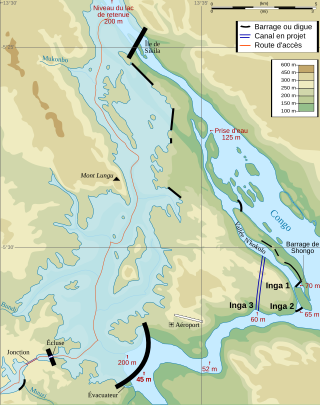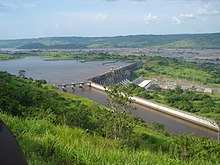
The Inga Dams are two hydroelectric dams connected to one of the largest waterfalls in the world, Inga Falls. They are located in the western Democratic Republic of the Congo and 140 miles southwest of Kinshasa.

Energy in Bulgaria is among the most important sectors of the national economy and encompasses energy and electricity production, consumption and transportation in Bulgaria. The national energy policy is implemented by the National Assembly and the Government of Bulgaria, conducted by the Ministry of Energy and regulated by the Energy and Water Regulatory Commission. The completely state-owned company Bulgarian Energy Holding owns subsidiaries operating in different energy sectors, including electricity: Kozloduy Nuclear Power Plant, Maritsa Iztok 2 Thermal Power Plant, NEK EAD and Elektroenergien sistemen operator (ESO); natural gas: Bulgargaz and Bulgartransgaz; coal mining: Maritsa Iztok Mines. In Bulgaria, energy prices for households are state-controlled, while commercial electricity prices are determined by the market.
The energy policy of India is to increase the locally produced energy in India and reduce energy poverty, with more focus on developing alternative sources of energy, particularly nuclear, solar and wind energy. Net energy import dependency was 40.9% in 2021-22.

Iran has the Third largest oil reserves and the 2nd largest natural gas reserves in the world. The nation is a member of OPEC, and generates approximately 50% of state revenue through oil exports.
Venezuela has the largest conventional oil reserves and the second-largest natural gas reserves in the Western Hemisphere. In addition Venezuela has non-conventional oil deposits approximately equal to the world's reserves of conventional oil. Venezuela is also amongst world leaders in hydroelectric production, supplying a majority of the nation's electrical power through the process.

Burning of renewable resources provides approximately 90 percent of the energy in Uganda, though the government is attempting to become energy self-sufficient. While much of the hydroelectric potential of the country is untapped, the government decision to expedite the creation of domestic petroleum capacity coupled with the discovery of large petroleum reserves holds the promise of a significant change in Uganda's status as an energy-importing country.

Ghana generates electric power from hydropower, fossil-fuel, and renewable energy sources such as wind and solar energy. Electricity generation is one of the key factors in order to achieve the development of the Ghanaian national economy, with aggressive and rapid industrialization; Ghana's national electric energy consumption was 265 kilowatt hours per each one in 2009.

Vietnam is a dynamic developing economy with a relatively high growth rate. The energy sector plays a key role in promoting the country's socio-economic development. Vietnam has a diverse energy fuel resource of various types such as coal, natural gas, petroleum, hydropower and renewables such as solar and wind energy. The country has recently been successful in renewable energy deployment, especially solar and wind power development. Coal has been the key power generation source since 2018. Coal accounted for about 30% of installed capacity and 47% of electricity generation in 2021 The high use of coal makes Vietnam an increasingly important emitter of carbon dioxide, contributing to climate change.

EnergyinSaudi Arabia involves petroleum and natural gas production, consumption, and exports, and electricity production. Saudi Arabia is the world's leading oil producer and exporter. Saudi Arabia's economy is petroleum-based; oil accounts for 90% of the country's exports and nearly 75% of government revenue. The oil industry produces about 45% of Saudi Arabia's gross domestic product, against 40% from the private sector. Saudi Arabia has per capita GDP of $20,700. The economy is still very dependent on oil despite diversification, in particular in the petrochemical sector.
Electricity in Paraguay comes almost entirely from hydropower. As Paraguay is landlocked and has no significant natural gas reserves, its citizens often burn firewood which contributes to deforestation. The government imports fuel to use, and state-owned Petróleos Paraguayos (Petropar) has a monopoly on all crude oil and petroleum product sales and imports in Paraguay. It operates Paraguay's sole refinery, the 7,500 bbl/d (1,190 m3/d) Villa Elisa facility.

This article describes the energy and electricity production, consumption and import in Egypt.

Energy in Afghanistan is provided by hydropower followed by fossil fuel and solar power. Currently, less than 50% of Afghanistan's population has access to electricity. This covers the major cities in the country. Many rural areas do not have access to adequate electricity but this should change after the major CASA-1000 project is completed.
Two-thirds of energy in Azerbaijan comes from fossil gas and almost a third from oil. Azerbaijan is a major producer of oil and gas, much of which is exported. Most electricity is generated by gas-fired power plants.

The Grand Inga Dam is a series of seven proposed hydroelectric power stations at the site of the Inga Falls, in the Democratic Republic of the Congo. If built as planned, the 40-70 GW project would be the largest power station in the world.
Three primary energy sources make up the energy mix in Guinea: fossil biomass, oil and hydropower. Biomass makes the largest contribution in primary energy consumption. It is locally produced, while Guinea imports all the petroleum products it needs. The potential for hydroelectric power generation is high, but largely untapped. Electricity is not available to a high percentage of Guineans, especially in rural areas, and service is intermittent, even in the capital city of Conakry.
Energy in Serbia describes energy and electricity production, consumption and import in Serbia.

This article describes energy and electricity production, consumption, import and export in Kenya. Kenya's current effective installed electricity capacity is 2,651 megawatts (MW), with peak demand of 1,912 MW, as of November 2019. At that time, demand was rising at a calculated rate of 3.6 percent annually, given that peak demand was 1,770 MW, at the beginning of 2018. Electricity supply is mostly generated by renewable sources with the majority coming from geothermal power and hydroelectricity.

Nepal is a country enclosed by land, situated between China and India. It has a total area of 147,181 square kilometers and a population of 29.16 million. It has a small economy, with a GDP of $33.66 billion in 2020, amounting to about 1% of South Asia and 0.04% of the World's GDP.
Burning of charcoal and wood fuel provides approximately 94 percent of the energy in Malawi. Much of the renewable hydroelectric potential of the country is untapped. As per 2018 Population and Housing Census, the national electrification rate in Malawi was 10%, with 37% of the urban population and only 2% of the rural population having access to electricity.
Grand Katende hydroelectric power station is a hydropower plant under construction in the Democratic Republic of the Congo, with installed capacity of 64 megawatts (86,000 hp). When completed, it will be operated by the Congolese electricity utility company, Société Nationale d'Électricité (SNEL).















